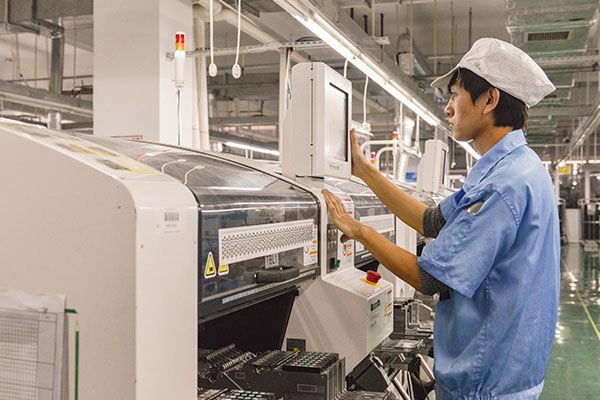Supply Chain Shortage | Explaining the Electronic Parts Shortages
An interview with an EMS (Electronics Manufacturing Service) executive, Scott Wiley, Ark Electronics’ COO
First of all, what is this supply chain shortage that people have been discussing for the last 2 years?
While it seems that everyone has heard the term “Supply Chain Shortage” today, the typical person may have never heard the term “Supply Chain” prior to 2021. While many still might not understand much about it, they know that it is blamed for the scarcity of many products—including electronic products that consumers just can’t get enough of—like iPhones, laptops, and servers. Those are the obvious ones. Then there are also products that we don’t traditionally think of as “electronic products” but that contain critical electronic components—like automobiles for instance.
If anyone has driven by a car dealer’s lot lately, they can attest there aren’t many new cars on display.
Why not?
Because even automakers, with all their buying power and clout, can’t get the semiconductor components required to complete that last 1% or 2% of the car’s content.
What most people don’t know is that a car requires about 1,400 different semiconductors to make. Features like touch panel displays, emergency braking systems, airbag deployment systems, on-board camera systems all require semiconductor chips.
It has been reported that the auto industry lost over $100 Billion in revenue since early 2021 due to the inability to get semiconductors that are needed for their cars.
There was an article that I saw recently about Supply Chain Shortage that referred to something called the “Asian squeeze.” It stated:
“At the root of the Supply Chain Shortage or squeeze is the under-investment in 8-inch chip manufacturing plants operated in Asian countries, which have struggled to ramp up production as demand for 5G phones and laptops picked up faster than expected.”
So, there’s the shortage of some kind related to a specific range of component parts that affects the supply chain. Is it really a thing, this so-called “Asian squeeze”?
Well, even if it has a given name, it is not such a narrow issue that the name implies. I mean, there is clearly more demand than supply. That indicates that we have less capacity than we need. Part of the reason is that it’s not cheap to build a chip factory . There are many estimates of varying investment, but it’s safe to say it’s probably at least $10 billion over five years.
So even under normal circumstances and normally expected ramp of demand, the fix of Supply Chain Shortage is not inexpensive and it’s not quickly implemented. Keeping that in mind, today’s world is anything but “normally-expected ramp of demand.”
 What happened? The semiconductor Supply Chain Shortage has been described by many as the “perfect storm” of complicating factors
What happened? The semiconductor Supply Chain Shortage has been described by many as the “perfect storm” of complicating factors
Even before 2020, there were already starting to be some Supply Chain Shortages of certain older varieties of chips due to the lack of both raw materials and manufacturing equipment needed to produce those chips. Add to that several disruptions that were “once in a century” type events.
Specifically, we had:
- COVID which shut down entire countries and disrupted both the raw materials supply and the production of many semiconductors. However, COVID was only one of the disruptions. It may have been identified from the press as the major noticeable factor, but it is only one of the circumstances that created the Supply Chain Shortage. We’ll come back to that.
- In addition to COVID, we had fires in two different locations and a significant weather event hurting production
- one fire was in Berlin Germany at ASML Holding – the sole provider of a vital technology used to manufacture the most advanced computer chips
- the other fire was in in Japan and is referred to as ”the Renesas fire,” on March 19th, 2021. This fire especially hurt the Auto industry in particular. That factory was out of commission until late June of 2021 with a huge backlog that took months to catch up.
- Even extreme weather events, including what has been called “The Storm of the Decade” shut down several factories in Texas in early 2021 due to a widespread power outage in the U.S. state of Texas. Normally a power outage would be a blip. Instead, it made a very bad situation even worse as gas pipelines fueling power stations froze, moist air shut down turbines, and snow-covered solar panels could not generate electricity. For a typical factory, closing an industrial factory will often lead to a batch of “waste” products that can be generally ignored. However, semiconductor production processes cannot be halted, and when they do shut down unexpectedly, it can take months to recover fully.
- As I mentioned earlier, there was also an underlying growth in demand for chips as industries shifted to more semiconductor-intensive products (e.g., electric vehicles, 5G base station upgrades across the world, etc.)
- The pandemic drove huge increases in demand as a large part of the population began working from home and purchasing new computers, screens, docking stations, power supplies, conferencing phones, and the list goes on.
- And then to make matters even worse, we had the explosion of the cryptocurrency market and the associated heavy reliance on IT infrastructure to support the industry.
- There’s been a lot of investment in cryptocurrency and to the activity required to “mine cryptocurrency” it very IT intensive. The cryptocurrency-related mining demand and the growth of processing related to another boom in AI helped cause some of the early, pre-pandemic shortages that continue until today.
- As an addition, there are numerous new sectors that forecasters didn’t even really think to be considered as a market opportunity five years ago; or maybe they were severely underestimated when they were planning the timing of semiconductor factory builds.
What was the outcome of all these unforeseen circumstances?
The situation got so bad that the Biden Administration, through the Department of Commerce, dispatched an RFI (Request for Information) on the Semiconductor Industry supply chain that provided perhaps the first comprehensive census of the global semiconductor Supply Chain.
The Dept of Commerce received almost 200 responses that included nearly every major semiconductor producer and multiple of their large customers. Here are the findings, paraphrasing from a late January 2022 report from the Dept of Commerce:
- Between 2019 and 2021 demand for semiconductor increased as much as 17%. At the same time the supply was decreasing due to fires, weather events and other reasons that I’ve already mentioned. Put that together and you have a major supply and demand mismatch. As companies struggle to increase production, it takes years not months to build and to outfit a new semiconductor plant.
- The problem is described in mathematical terms by comparing the median inventory of semiconductor products by industry buyers. It has fallen from 40 days in 2019, to fewer than 5 days in 2021. In some industries the median inventories are significantly leaner.
What can be done? Can we implement a solid strategy to get out of the Supply Chain Shortage fast?
Well, there are both short term fixes and long-term fixes.
- In the short term, semiconductor fabricators have reacted and are working to squeeze out more production from existing plants and equipment.
- For instance, from Q2 of 2020 through 4Q2021, semiconductor fabs operated at over 90% utilization.
- That’s incredibly high for a production process that requires regular maintenance and very high amounts of energy.
- In comparison historically utilization has been in the high 70% range as recently as 1Q2019.
- Longer term, it’s clear that the primary bottleneck across the board at this point appears to be wafer production capacity, which requires a longer-term solution.
- I’ve seen estimates that put typical duration of building a semiconductor plant from greenfield to production taking from 3 -5 years to build.
- A fab complex is also a very special kind of building which is itself a special environment where foreign particle contamination is controlled. In a contemporary cleanroom, humans do not access many parts of the building, instead everything is robotically controlled.
- The most modern cutting-edge fab factory can easily cost upwards of US $10B.
Let’s go back to the starting point. There has been an extended conversation about the “COVID effect”. Could we identify the COVID effect as a trigger point to the shortage?
Actually, it’s a number of things that we have already pointed out. So, I don’t know that it’s all COVID. But COVID did surely negatively affect both the demand and the supply situations. Surely, we shouldn’t point to one thing, I don’t think it was one particular thing. There was evidence of shortages, and then of course once COVID hit, if you’re an OEM company producer that and you need the supply of components, and you can get it from multiple distributors, you might end up entering that same order on multiple distributors. And so, as they feed that back up to their headquarters, you can get a kind of an inflated view of what the demand is.
Then there’s hoarding. The general perception is that there’s a shortage of certain semiconductors right now. So, nobody’s going to turn loose of anything that they won’t eventually need. And if they can get more, they’ll buy more and stick the extra inventory in the warehouse.
A Supply Chain shortage is not something new. In order to handle any future supply volatility, last September for example, we put an order in for 20 months of demand to cover some of our critical needs. Prior to last year, typical lead times were averaging about 3 months.
And we are not the only ones.
There are other companies in front of us are large, Goliath-sized companies, that probably did the same thing, and even they are not getting everything that the need. You can be sure that as product starts to flow, they are likely going to get the little bit of stuff that’s trickling through.
You know, if you’re GM and you consume a 10 million chips a month, and any shortage prevents you from completing the assembly and therefore selling a car that you otherwise have every other component needed to make it, you might buy five years’ worth of supply if you can get.
It’s like any other shortage, when people believe there is a shortage in supply, they start hoarding. We all saw that happening in our own private lives.
Remember when you couldn’t buy toilet tissue at the beginning of COVID? Do you recall the reason why you couldn’t buy toilet tissue? Well, some Social Media posts stated something along the lines of: “Oh, we’re out, my store is out!” And it spread virally along with a few pictures of empty shelves to emphazise the point. What did everyone do? Of course, they went and bought, you know, six years supply and stuck it in their closets or garage or basements. The shortage became a self-fulfilling prophecy.
There was no REAL increase in usage or demand. There was not significant reduction in demand. There was hoarding—pure and simple.
How long can Supply Chain Shortage go before it is resolved?
I have listened in on analyst calls where some of the largest multi-Billion-dollar companies are expressing HOPE, and I do mean HOPE instead of hard evidence, that the semi-conductor shortage might be over in the 2nd half of 2022 so that they can fulfill orders again. While a full recovery in 2nd half of 2022, may be true for some industries, I’m guessing many industries will not see free supply of semiconductors until well into 2023.
For the consumer’s point of view, consider a typical consumer product. It might have 200 to 300 semiconductor components in it. ALL of those components, ALL of them, have to be available. If one critical one is missing, then guess what? The company cannot produce that product.
One last remarkable item:
I have heard a story of a certain producer of high value goods purchasing 250 washing machines that had the same rare component in it that the producer needed to complete his product. That manufacturer dissected the washing machines and harvested that one rare component from the appliances in order to use it in his own production to make his own product. While that’s an extraordinary instance, that’s how bad it can get. And the business case around that instance surely made sense or the company would not have gone to those lengths to solve the problem of a Supply Chain Shortage in that way.
Is there is a prediction of how we are going to overcome this Supply Chain Shortage or when?
Well, many “experts” have an opinion, but they are opinions. I was on the earnings call for a Fortune 100 company about a month ago. And you’ve got the CEO of that company, talking with analysts. He said, and I am paraphrasing, “our earnings were, about a $1 lower per share in the last quarter than we expected and it’s due to the semiconductor shortage”.
Now, a CEO talking to a group of analysts wants to say, “but that’s behind us”, OK? But, incredibly, he didn’t say that. He said, “we’re HOPEFUL that it’s behind us. But we don’t really know”. So, if the CEO of a Fortune 100 company doesn’t know, then, somebody with far fewer resources than a Fortune 100 CEO, who claims to be an “expert” and who is paid to have an opinion, whether it’s right or wrong, probably doesn’t know either what will eventually happent to overcome this Supply Chain Shortage.
Also, I think there are several unknowns. As I just said before, how many of the orders that are out there are real? If a company needs, let’s say, a million of some semiconductor parts per month, and they order 20 months of stock just to be safe from six different distributors, then they really only need a million components if they operate on a just-in-time inventory replenishment system, but for the supplier, it looks like 120 million.
See how the math works? 1 million needed per month X 20 months X 6 distributors. That’s 120 million, when the OEM really only needed 1 million components to supply his factory for the next month. I don’t think anybody really knows the extent of that sort of overstated demand. One thing for sure, it will take time for the entire supply chain to normalize and unwind. Then and only then will we begin to see what true demand is.
So that’s where we are. I think there are few people that believe that Supply Chain Shortage is going to be behind us before, perhaps, deep into 2023; unless there’s a huge reversal. I just don’t see it happening. In the meantime, people that can get any kind of even remotely scare components, they are going to hoard them. Their attitude will be , if we get those excessive chips, we’re not turning them back. We’re going to keep every one of them.
So, what Ark Electronics is doing to handle the Supply Chain Shortage?
Companies like Ark Electronics are turning to new sources, firming up supply agreements, enlisting the help of our customers and others to influence the semiconductor manufacturers, finding substitutes that our customers approve of, and turning to the spot-market for hard-to-find components.
This is all with the intent of shaving days, weeks, and months from lead times on certain components and getting production rolling again. Those who are diligent are moving the needle and improving the situation incrementally for their customers.
Two years ago, I spent less than an hour a week solving supply chain problems. Now probably half my week, and often more is spent on supply chain issues. We just added a VP of Supply Chain level position focused specifically on this issue.
Bottom line, if that’s what it takes, then I am happy to do it if it means my customer benefits. We do whatever is necessary to serve the customer. Their problems are our problems. This is not some obscure exercise. We take this personally and we go to extraordinary lengths to help our customers. It’s not an exaggeration to say that we will do everything in our power to solve those problems.
In the end, it’s through efforts like these that that we will all weather this Supply Chain Shortage storm until the days of semiconductor component free-supply return.

Some Sources:
https://ustr.gov/sites/default/files/notices/FRN%20for%20Notice%20of%20Reinstatement.pdf
https://www.whitehouse.gov/wp-content/uploads/2021/06/100-day-supply-chain-review-report.pdf
https://www.commerce.gov/news/blog/2022/01/results-semiconductor-supply-chain-request-information
https://www.electropages.com/blog/2021/03/texas-power-outage-series-unfortunate-events-shut-down-semiconductor-foundries
https://www.pcgamer.com/semiconductor-supplier-asml-suffers-a-factory-fire-in-berlin/




